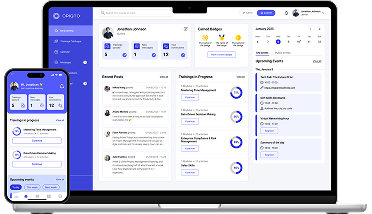We've discussed the unsustainability of face-to-face learning and the advantages LMS offers to corporate training. However, if you've ever tried to digitize L&D, you probably know firsthand how high dropout rates are for online courses. And let us assure you, you are not alone in this.
Even at MIT and Harvard, the number of students completing open courses averaged around 2-7%, forcing universities to paywall content and completion certificates. If even having the most brilliant classes written by eminent professors doesn't guarantee that students will stick through - clearly, there must be other factors at play apart from the content itself. What are those? And why should you care about reducing dropout if it's inherent to e-learning?
Let's go over the second question first.

Why is reducing the dropout rate worth the effort?
Measuring the impact of learning on an organization is far from straightforward. There are no formulas, definitive principles, and coherent methodology, and the online format, with its asynchronicity, only adds complexity to an already confusing matter.
What we have are common sense and some statistics. And they tell us that if learners don't even touch a course, there'll be no results to measure, and, even more importantly, there are some acute problems in a training approach. So reducing dropout is ultimately about finding pain points that get in the way of successful company training.
Now, what is success? The end goal of training is to teach employees skills they need to do their job better. Therefore, the more people complete the course, the more skillful employees the company will have and the more revenue they will bring. That's the first and most obvious reason to improve retention, and that's why dropout is the most widely used indicator of training success (or failure).
Next is the financial aspect. Building a corporate academy allows a company to establish systematic professional education and fully control all processes. That entails more efficient training and fewer expenses in the long run than a company would have spent on, let's say, buying off-the-shelf courses. But it still may cost a fair bit, and you pay upfront with no guaranteed returns. Employees should utilize the knowledge you provide to make this spending an investment, not a waste. And for that, they have to complete training first.
Finally, systematic employee training and education can transform a company if the team is consistently engaged. Once a culture of professional development has taken root in a team, one has to be in line to fit in, and this cycle keeps self-reinforcing. With each teammate motivated to get into training, the impact grows.
So don't be discouraged by low completion rates. At a minimum, learners who quit mid-course still garner knowledge from the modules they completed, so unfinished training is better than none. In fact, it's a fine starting point to build upon. Studies show that the more familiar you are with online courses and the better you know what to expect, the more likely you are to complete them. They also show that most dropout happens in the first 1-2 weeks. So help your employees get a positive experience from the start and establish a routine; over time, it will get easier to keep up for you and them.
It must be said that there is no consensus on how to tackle dropout, but there are plenty of findings on the reasons online students quit or carry on, and several factors appear persistently.

What factors affect the learning experience?
And what can you do about them?
Researchers have been studying the e-learning experience of public schools, universities, and online education platforms like Coursera, trying to understand the strengths and weaknesses of distance education for years now. They have identified dozens of factors that may correlate with dropout and course completion rates.
We've compiled several recent studies and grouped the most-cited factors into three categories: internal course-related reasons, learner characteristics, and external circumstances. Most of the papers mention most of the factors, so it's hard to cite someone in particular, so we'll just put some links we found helpful here:
- HarvardX and MITx report on the first year of open online courses (fall 2012 - summer 2013.)
- HarvardX and MITx report on four years of open online courses (fall 2012 - summer 2016.)
- "Why do open and distance education students drop out? Views from various stakeholders" by Ayşe Bağrıacık Yılmaz & Serçin Karataş, who conducted semi-structured interviews with students, field experts, instructors, administrators, and support staff - everyone involved in the learning process.
- "Dropout in online higher education: a scoping review from 2014 to 2018" by Marlon Xavier and Julio Meneses.
- And another scoping review, "Persistence and Dropout in Higher Online Education: Review and Categorization of Factors" by Umair Uddin Shaikh and Zaheeruddin Asif.
Though these studies predominantly focus on undergraduate students, many findings also hold for corporate online training. Here are aspects researchers consider significant and solutions we propose:
Course-related reasons
These are aspects concerning the content and organization of the courses, instructors, accessibility, platform properties, etc. - everything you are responsible for and have the most power over as a training provider. The way the educational process is organized plays a significant role in the learner's decision to finish or discontinue the course, and there are many ways to discourage a learner from online training:
Case 1
Problem: Learners have higher chances of dropping out when they have a false impression of the complexity, length, and contents of the course, when the workload is inconsistent, or when the material is either too simple or too difficult for them.
Solution: Set clear expectations about course objectives, assignments, difficulty level, etc., before enrollment. When there are different levels of course difficulty - set entrance exams to assign a learner to a challenging but not back-breaking course. Make sure that learners' workload remains more or less consistent so that they have an easier time planning their activities.
Case 2
Problem: Learners struggle to assess their progress and feel directionless, are left with no feedback, or cannot resolve questions related to the course content or assignments for days because trainers respond too slowly. When learners are stuck on a concept, and no one helps them for a week, they tend to fall off, understandably.
Solution: Make sure you are not understaffed. There should be sufficient instructors and trainers that can respond to learners' questions promptly and provide regular personalized feedback on their progress. Social features on your e-learning platform also go a long way, as learners can help each other to understand the material.
Case 3
Problem: Learners come with various levels of preparedness, objectives, and needs. A teacher in a live classroom can read the room and adapt the material on the go. Courses, however, are usually pre-built with an average learner in mind, so they are limited in their ability to cater to everyone.
Solution: Adaptive learning provides tools and techniques to tailor learning paths to individual needs. Another major point is to ensure content accessibility in line with the standards of web content design.
Case 4
Problem: Instructors are underqualified or biased against distance learning. Doubt not - learners read that attitude perfectly well.
Solution: Educate your educators. Online learning has its limitations and disadvantages, but so does traditional education. Both can be effective when done right, and prejudice will only kill a healthy inquisitive atmosphere.

Case 5
Problem: Your e-learning platform is outdated, bugged out, too slow, or incompatible with learners' equipment.
Solution: Audit and update your IT infrastructure, switch to a better vendor, or set up a new and responsive solution in-house. While it sounds tedious and expensive, a timely hardware and software upgrade is much cheaper and more manageable than putting out fires later. Besides, it may not be as expensive as you'd imagine, with open-source LMSs like Opigno freely available.
Overall, it's fundamental to actively collect learners' feedback about your programs, platform, instructors, etc., during and after each course and mitigate as many issues as possible.

Learner characteristics
Online learning is usually self-paced, so personal characteristics play a huge role in the study outcome. We are talking about personality, motivation, habits and discipline, psychological traits, skills, and experience.
While training providers cannot change learners' character and personality, they can account for them while designing the course.

Case 1
Problem: People are used to traditional, face-to-face learning with its teacher-student and student-student connections, higher level of control, and immediate two-way feedback. Distance and primarily asynchronous learning deprive them of the level of interpersonal engagement they are accustomed to.
Solution: There are ways to make online learning a less lonely experience, e.g., via implementing direct messaging, forums, group tasks, live-stream events, etc. Social and blended learning approaches focus specifically on this aspect.
Case 2
Problem: It takes learners more effort to self-organize, stay motivated and involved when they are on their own with the course material.
Solution: Our brains are lazy. They jump to familiar behavior patterns and render any effort undue when the profit's not clear, and there are no repercussions for slacking. So a good course design addresses all these human shortcomings:
- Regularly underscores course objectives and explains what the person will achieve by finishing the module, what skills they will acquire, and how they can utilize them in their job.
- Provides external motivation through a reward-punishment system. A great way to give instant gratification is through gamification - using game mechanics such as achievement badges, leaderboards, earning points, content that should be "unlocked" by finishing tasks, etc.
- And nurtures new habits through reminders, deadlines, and establishing a routine, e.g., consistent module structure and regular follow-ups with the instructor.
Case 3
Problem: Learners might be unequipped psychologically to commit to the training. Specifically, poor self-regulation skills (ability to deal with one's mood, distractions, stress, etc.) and low self-efficacy (the "I can do it" mindset) lead to high dropout, as such students cannot bring themselves to overcome the hurdles they inevitably face during the training.
Solution: Sometimes, we need to learn how to learn. If you have resources to provide such training - that's fantastic! Otherwise, you can make some minor adjustments to push learners to do better gently. Adding self-questionnaires after lessons, for example, helps learners develop reflection skills and stay mindful of the learning process.
And self-efficacy is achieved by reframing the person's perception of the goal as feasible:
- Showing how the task is similar to what they've already done successfully and gradually building on the task's complexity.
- Breaking it down into smaller, simpler steps.
- Showing that other teammates were able to complete the task.
Again, with their quests, scores, and badges, game mechanics prove to be quite helpful here.
Case 4
Problem: Online learning demands a certain level of digital literacy that a learner may not meet. People with poor technical skills or not used to working with digital content will find it especially hard to acclimatize to the online training format.
Solution: Make courses newbie-friendly - easy to navigate, with an intuitive interface, and fast to load on mobile devices. Provide information on the software learners will use and the user guides - where to find materials online and offline, how to submit assignments, etc.
Studying is hard. We haven't evolved to sit still for several hours a day and stare at monitors, trying to wrap our heads around some abstract concepts. When human nature interferes with professional development, good training design tricks employees into learning consistently and persisting.

External circumstances
These are outside factors that shape the learner's environment - family responsibilities, the workload at the job, financial stability, external support, or lack thereof. There's only one problem - most of the time, neither you nor the learner has the power over external circumstances. So there's nothing much to say except be compassionate to your learners.
As for the training, ideally, it should provide a support system for growth, meaning that the courses are agile enough to be adjusted to external obstacles.

The dropout is "the canary in the coal mine" of e-learning. It will always be higher compared to traditional learning rates but if it starts creeping up even more - something is wrong.
Even though the academic community still needs to work out a cohesive dropout theory, it is already clear that this is a multifaceted phenomenon. Learners' attrition and retention depend on a wide array of factors, and most theories agree that these factors fall into three groups: related to the training itself, the learner's traits, and external factors.
Each person's situation is unique, and no single factor can predict a learner's decision to complete or drop online courses. So no one-size-fits-all solutions here, unfortunately. However, the majority of these factors can and should be addressed as that will improve the corporate training experience and immensely profit the company in the long term. By listening to learners' feedback and analyzing their performance, you can tailor your training platform to fill your and your employees' needs.
Published on January 10, 2023
